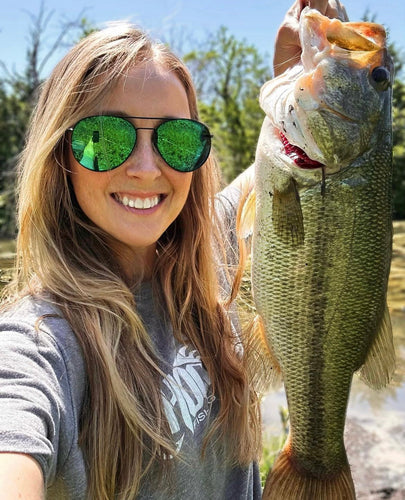Hollow-Body Frog Tips

Down here in Texas we are entering into frog fishing season. It typically picks up post spawn and once water temperatures hit around 60 degrees. It is one of the few reasons I’m thankful for the often brutal Texas heat, because I absolutely love frog fishing. There’s nothing like seeing a bass explode out of the water to grab your frog and feeling the weight as it takes it under. It’s one of the most exciting ways to catch them in my opinion.
If you’re new to frog fishing or just looking to increase your hookup ratio, below are a few tips to help you get more frog bass!
Walk Your Frog
A traditional hollow-body frog is made for walking. Sure you can get bites by just twitching it across the water, but getting that perfect side-to-side action gives it extra drawing power, especially in open water. Plus it keeps it the frog place longer to give bass more time to grab it. Walking a frog can take some practice but it really pays off. Use short downward twitches while slowly reeling up slack. Problems usually arise from not having enough slack in your line or twitching the rod too hard. Also some frogs are easier to walk than others; see my frog recommendations at the bottom and try one of those to see if it helps. You can also try trimming the legs with one slightly shorter than the other. However the number one way to learn to walk a frog is by practicing. You can read a million articles on how to do it but practicing repeatedly is really the only way to learn.
Wait a Second
When you see a bass blow up on your frog, the often knee-jerk reaction is to set the hook immediately. It’s one of the hardest lessons I had to learn initially. I always wait a second or two to set the hook. It gives the bass time to really inhale it and ensures that you will not rip it straight out of their mouth. I watch my frog closely as well. Sometimes bass will just straight up miss the frog. You might see a big blow up but your frog is still sitting on top of the water. When this happens I wait a second before moving it again because sometimes the bass will come right back for it. Other times bass will simply inhale it under and you will not see a blowup, so watching your frog is extremely important.
Target Vegetation
I usually start by throwing my frog on the outer edges of vegetation mats. Bass will often sit at the edges of these mats and as soon as you bring your frog over the edge they will explode. If there are cattails/reeds, I will throw my frog as close to the base of them as possible and often get blowups as soon as it hits the water. If you’re in open water without a lot of surface vegetation, try a frog with noisy appendages, such as the Teckel Sprinker (which features a plopper-type tail). This will give it extra drawing power.
Pick the Right Color
I stick with pretty basic colors. Black or brown for sunny days and clear water. Black or bright colors for muddy water. White or bright colors for cloudy days. Patterns on the belly can mimic baitfish as well.
Have the Right Setup
A baitcasting rod is the way to go unless you are using a very small frog. I recently moved from using a medium-heavy power rod to using a 7’3″ heavy rod for frogging. I appreciated the difference immediately when setting the hook and wrenching them out of the heavy vegetation. A medium-heavy rod will still work for frogging, but a heavy power rod will give you that extra leverage, especially for bigger fish and heavy cover. I use a 7:3:1 gear ratio but many people like a faster reel to get them out of heavy cover quickly. Always use straight braid with frogs. I use 65 lb Power Pro for fishing heavy cover.
My Recommendations
Spro Bronzeye 65 – $11.99
Booyah Pad Crasher – $6.99
Megabass Big Gabot – $15.99
I hope these tips help you going into frog season!
Tags
baitcasting
bass fishing
Booyah Pad Crasher
fishing
fishing tips
hollow-body frog fishing
Megabass Big Gabot
Spro Bronzeye 65
Teckel Sprinker




